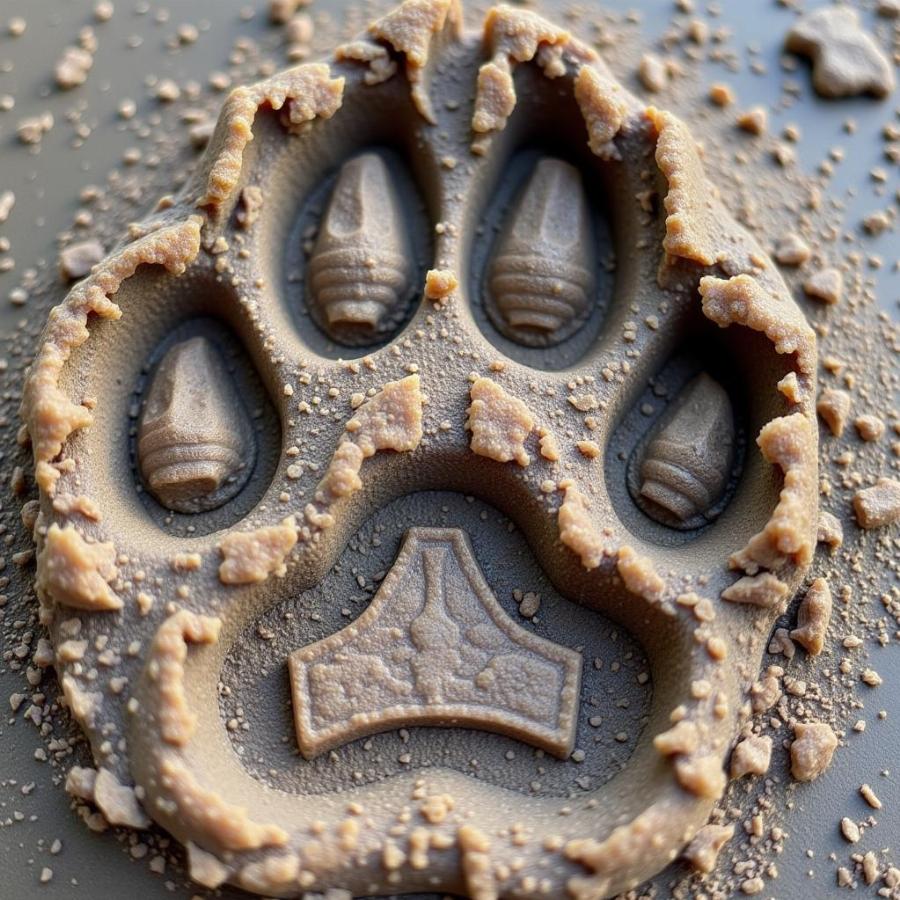Dog paw prints are more than just cute marks left on the freshly fallen snow or a muddy patch in the yard. They are a unique identifier for your canine companion, much like our fingerprints. Understanding the outline of a dog paw print, or “outline of dog paw print” as some might search for it, can offer fascinating insights into your dog’s anatomy, gait, and even overall health. This article will delve into the intricacies of these adorable imprints, explaining what they can tell us about our furry friends.
Deciphering the Details of a Dog Paw Print
A typical dog paw print consists of four main toe pads, a larger central pad (often referred to as the metacarpal pad on the front paws and the metatarsal pad on the rear paws), and sometimes a dewclaw print, which is located higher up on the leg and often doesn’t register in a print. The arrangement, size, and shape of these elements within the outline of dog paw print offer a wealth of information.
 Details of a dog paw print
Details of a dog paw print
For instance, a dog used to walking on hard surfaces might have harder, more calloused pads, resulting in a less defined outline of dog paw print. Conversely, a dog that frequently walks on soft ground will likely have softer pads and a more pronounced print.
How to Identify a Dog’s Gait from its Paw Prints
The spacing and pattern of paw prints can reveal a dog’s gait. A trotting dog will typically place its hind paws slightly ahead of its front paws, creating a distinctive pattern. By analyzing the outline of dog paw print sequences, you can tell whether your dog is walking, trotting, running, or galloping. This can be especially useful for trackers and hunters.
Identifying Different Gaits
- Walking: Front and back paws alternate, with the hind paw landing behind the front paw.
- Trotting: Diagonal pairs of paws move together (front left and back right, then front right and back left).
- Running: Similar to trotting, but with a longer stride and a moment where all four paws are off the ground.
- Galloping: All four paws move independently, with a distinctive “leaping” pattern in the paw prints.
The Significance of the Outline of Dog Paw Print in Veterinary Medicine
Vets can sometimes use the outline of dog paw print to assess a dog’s overall health. Unusual wear patterns, swelling, or asymmetry in the prints can indicate underlying problems like arthritis, injuries, or even neurological conditions. While paw prints alone aren’t a diagnostic tool, they can provide valuable clues that warrant further investigation.
Frequently Asked Questions about Dog Paw Prints
- Why are my dog’s paw prints sometimes bigger or smaller? Factors like temperature, ground surface, and the dog’s activity level can all affect the size and clarity of the paw print.
- Can you identify a dog breed from its paw print? While some general size correlations exist, it’s generally not possible to reliably identify a breed solely from a paw print.
- Do all dogs have dewclaws? Not all dogs have dewclaws, and some breeds even have double dewclaws. Their presence or absence often depends on breed and genetics.
Conclusion
The outline of a dog paw print is far more than just a cute impression. It’s a window into your dog’s anatomy, movement, and even health. By understanding the intricacies of these prints, you can gain a deeper appreciation for your furry friend and potentially even spot early signs of health issues. Remember to consult with a veterinarian if you notice anything unusual about your dog’s paws or gait.
Beaut Dogs is the perfect destination for dog lovers, providing reliable and in-depth information about the world of canines. Visit Beaut Dogs today to explore our vast library of resources on dog breeds, care, and more. For any assistance, please contact us at Email: [email protected] to get detailed and accurate answers from Beaut Dogs.